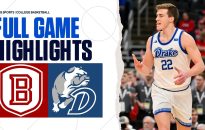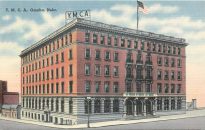Following an exhaustive door-to-door effort last year to renegotiate agreements with athletic directors and a critical financial overhaul in September 2023, Learfield’s CEO and President Cole Gahagan is witnessing the growth and expansion of his organization despite some unresolved uncertainties about what’s next.Courtesy of Learfield The mural at the center of Learfield’s contemporary Dallas headquarters […]


Following an exhaustive door-to-door effort last year to renegotiate agreements with athletic directors and a critical financial overhaul in September 2023, Learfield’s CEO and President Cole Gahagan is witnessing the growth and expansion of his organization despite some unresolved uncertainties about what’s next.Courtesy of Learfield
The mural at the center of Learfield’s contemporary Dallas headquarters serves as a representation of both its future and its history.
This two-story artwork, commissioned from a local artist, is rich with hidden meanings: A block “M” symbolizes the company’s origins in Missouri, while a State Farm logo signifies Learfield’s engagement in sponsorships, among other details.
Among this artwork, there are additional indications of Learfield’s prospective direction — prominently, a series of 24 black and white dots that convey the word “data” in binary code.
“A traditional timeline ceases to grow the moment you place it on a wall; often, nothing new is added thereafter,” explained Kristine Schroeder, Learfield’s chief people and culture officer. “This was our chance to narrate our story through illustration.”
Viewing the past 15 months as a renovation period for Learfield, the company has traversed serious financial hardships, heightened its focus on data, and broadened its business services.
The organization achieved a recapitalization in September 2023 that substantially diminished its $1.1 billion debt, contributing an additional $150 million in new investments. Throughout this process, CEO and President Cole Gahagan traveled extensively across the nation to revamp agreements and uphold the majority of the company’s clientele, all while avoiding bankruptcy.
Since then, Learfield has experienced unprecedented financial advancement over the past year, generating $1.2 billion in gross revenue, even though it still carries a debt exceeding $500 million. Nevertheless, it now maintains debt ratios closer to 3.5-4 times its EBITDA, according to Gahagan, which is a marked improvement from the 30 times its earnings noted in mid-2022 by Moody’s.
This raises two key inquiries: 1) How can Learfield persist in expanding its business and diversifying its services to ensure a more financially secure future? Or 2) If unable to do so, what implications would that hold for the organization?
In light of their endeavors, Learfield’s top executives emphasize the pathways toward a restructured business and an optimistic outlook ahead of their transition into their luxurious new DFW headquarters.
“Our goal is quite straightforward: to keep the company operational and growing successfully to generate more free cash flow, which we can allocate toward reducing that debt and diminishing that ratio,” Gahagan stated. “We’ve accomplished that over the last year, and we intend to persist with this strategy in the upcoming years.”

The mural visible as one enters Learfield’s new premises symbolizes not just the company’s legacy, but also its aspirations.Courtesy of Learfield
■ ■ ■ ■
Learfield’s diverse visions and transformations over the past 15 years since founder Clyde Lear’s retirement may well fill the pages of a Dan Brown thriller. However, since Gahagan took the reins in January 2020 alongside the debt restructuring, a more stable long-term strategy appears to be emerging.
The current structure of Learfield revolves around five operational segments: its conventional marketing and multimedia rights business, the Collegiate Licensing Company (licensed merchandise), Paciolan (ticketing services), Sidearm Sports (official athletic websites and mobile applications), and Amplify (ticket and seating services).
The organization has also been consciously repositioning itself, as Gahagan notes, to become more of a media and technology entity. More specifically, it is enhancing stakeholder offerings via its Compass NIL platform, digital marketing strategies, and content development — all of which have been integral to the smart allocation of the $150 million cash boost.
“We serve primarily as a service provider,” said Cory Moss, President of brand management and marketing. “[Schools must] win games. They need to attract students. They have to effectively manage coaching staff. These are their core competencies. We, on the other hand, can leverage our expertise to excel in our domain.”
The Learfield Profile
Founded: 1972
Employee Count: 2,000-plus
Base of Operations: Dallas
Leadership Team
Cole Gahagan, President/CEO
Kim Damron, President, Learfield Sports Properties
Peter Lori, Chief Financial Officer
Ben Mathan, Chief Strategy Officer
John Raleigh, Chief Legal Officer
Cory Moss, President, Brand Management and Marketing
Kristine Schroeder, Chief People and Culture Officer
Learfield Studios, the firm’s internal media production division, reported a 20% year-over-year revenue increase within Power Four schools, according to information shared by a company representative. This venture partnered with Iowa’s Hawkeye Sports Properties, earning Learfield its inaugural regional Emmy for the three-part docuseries “Crossover at Kinnick presented by State Farm,” which focused on Iowa women’s basketball’s preseason game at the football stadium.
Recent advancements also include Learfield unveiling its “Edge” marketing agency in November, aiming to provide digital marketing tactics to enhance brand-consumer engagement and revenue generation, alongside creating a database of 150 million reachable fans aimed at driving more targeted marketing initiatives for brands and schools.
Learfield has reportedly observed a 280% year-over-year revenue increase from Power Four partnerships, with over 40% of Learfield’s sponsorships integrating NIL being newcomers to college athletics, as per financial reports provided by the company. National sales have also grown by 18% year over year.
“I would emphasize that the foundation of the ‘new Learfield’ revolves around data,” remarked Ben Mathan, chief strategy officer and a 2024 SBJ Forty Under 40 honoree. “It all begins with this database of 150 million reachable fans.”
The evolving Learfield model parallels growing dialogues in college sports about institutions managing multimedia rights and sponsorship sales independently rather than relying on traditional third-party vendors. The rationale for colleges opting to undertake these efforts internally is that they could capture full profits from their own sponsorships rather than share a percentage with Learfield or another provider.
“Owning all your assets enables you to collaborate more closely with your sponsors and integrate them more within your department,” noted Cincinnati Athletic Director John Cunningham, who directed the university’s separation from Learfield to establish its own entity, Cincy Sports Partners.
For many years, Learfield provided substantial guarantees to partners that financially supported athletic departments, which contributed to numerous financial challenges. The inability to fulfill these guarantees was also a factor that led several clients to seek other partnerships.
In response to inquiries specifically about recent deal structures and revenue-sharing agreements, Gahagan mentioned that deals vary by institution but the company has engaged in numerous agreements recently that ensure “both parties — the institution and Learfield — have mutual incentives, if not equal motivations, to foster the partnership.”
“From a business standpoint, Learfield has been perceived as a ‘friend’ to college athletics. I personally believe that perspective may not be as congenial as it once was,” remarked a Power Four source, who spoke on condition of anonymity due to their affiliation as a Learfield client. “… Cole is never going to approve a deal that could lead to financial instability again, even if it means losing additional properties.”

Learfield assisted Arkansas in adding Tyson Foods logos to its field. Courtesy of Learfield
■ ■ ■ ■
Learfield’s outlook is brighter than it was a year ago, although uncertainties persist.
The company bears $565 million in debt, however, it is worth noting that the debt ratios have markedly reduced. Learfield’s EBITDA has also demonstrated a 73% compounded annual growth rate from fiscal year 2022 to fiscal year 2024, signifying “robust company performance and expansion.”
In October, S&P Global awarded the company a “B” issue-level rating, indicating that Learfield is “more susceptible to business, financial, and economic fluctuations but currently possesses the ability to fulfill its financial obligations.”
“Typically, companies emerging from a restructuring or recapitalization tend to focus immensely on that process, leading to a delay in returning to growth after reshaping their balance sheets,” stated Jon Henes, founder and CEO of C Street Advisory Group, who acted as an adviser for Learfield during the debt restructuring. “However, in this instance, it has been quite impressive. They’ve achieved record revenues and EBITDA. Cash flow is exceptional.”
Gahagan indicated that Learfield has no intentions of divesting assets, although the long-term impact of its recent majority ownership by Clearlake Capital Group, Charlesbank Capital Partners, and Fortress Investment Group remains unclear.
“They and other traditional rights owners are going to face increasing scrutiny,” commented an industry source on the condition of anonymity. “The rapid growth in commercialization is promising, but how much will you retain? … When you have $1.2 billion in revenue, $500 million in debt appears manageable. Nonetheless, that $500 million in debt still incurs substantial interest before yielding any profit.”
Regardless of ongoing questions, Learfield has renewed or renegotiated agreements with over 30 school partners in the last two years, encompassing major clients such as Alabama, Boise State, Colorado, SMU, Indiana, and Purdue. The next step involves relocating to the new office, signifying a quasi-fresh start for the over half-century-old company as it aims to endure for another five years and beyond.
“For those familiar with the ‘old Learfield,’ this is a remarkably different atmosphere,” stated Kim Damron, president of Learfield Sports Properties. “The present-day Learfield, candidly, appears entirely different — and I believe this transformation will continue.”














